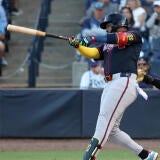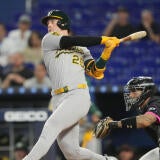
Last weekend, Pittsburgh Pirates right-hander Paul Skenes became the first player in Major League Baseball history to be selected to an All-Star Game the summer after they were drafted No. 1 overall. It's the latest in a growing list of achievements for Skenes, who will make his 11th career big-league start this afternoon against the Milwaukee Brewers.
For those who haven't been paying attention (shame on you), Skenes has amassed a 2.12 ERA (194 ERA+) and a 6.50 strikeout-to-walk ratio through his first 10 starts. His contributions have been worth an estimated 2.7 Wins Above Replacement, according to Baseball Reference. That's a gaudy figure for someone who didn't debut until mid-May.
We here at CBS Sports figured, then, that this would be a good occasion to honor Skenes -- inarguably one of the sport's most exciting players -- ahead of his final start of the first half. With that in mind, scroll slowly with us as we highlight four things worth knowing about Skenes before he takes an MLB mound for the 11th time.
1. Still throws hard
Shocking, right? Skenes will enter today's game having thrown 367 four-seam fastballs in the majors. He's averaged 99.2 mph on those heaters, topping out at 101.9 mph in the process. For reference, here's a complete list of starting pitchers to beat that this year:
We didn't leave that space blank by accident. Skenes is and will remain the hardest throwing starter in all of MLB. (The next hardest throwing starter with any amount of service time this year is Cincinnati Reds right-hander Hunter Greene; his average fastball has clocked in at just under 98 mph and his maximum velocity is 100.9 mph.)
Paul Skenes, 8th K pic.twitter.com/5kgYMzvlDe
— Rob Friedman (@PitchingNinja) July 6, 2024
Perhaps the best way to put Skenes' elite arm strength into proper context is to note that he would rank fourth-hardest thrower among relievers. There's a world of difference in airing the ball out for an inning versus doing it reliably over six-plus frames; it's a testament to Skenes that he's able to render that particular element irrelevant.
2. Sinker is a gamechanger
We've detailed before how Skenes added a mid-90s sinker (his term for it, though the pitch identification algorithms often classified it as a splitter) to his arsenal ahead of this season. Call it what you want, it looks like an elite pitch by any name.
Paul Skenes, Filthy 96mph Splinker. 😷 pic.twitter.com/t6S0lVzxFT
— Rob Friedman (@PitchingNinja) July 5, 2024
Coming into today, Skenes will have thrown more than 300 sinkers on the season, good for a usage rate north of 30%. Opponents have hit .181/.246/.222 with zero home runs and just three total extra-base hits off the sinker. Additionally, they've whiffed on 30.1% of the swings they've taken against it, second in his arsenal only to his four-seam fastball.
It's not often that a pitcher can introduce a new offering to their arsenal, use it as often as Skenes is deploying his sinker, and have it remain so effective through a solid sample size. As such, you cannot tell the story of Skenes' ascent without emphasizing how important the development -- and, really, the mastery -- of his sinker has been to his rise.
3. Innings load could become a talking point, again
You're likely tired of reading about Skenes' workload. We understand. Nevertheless, we feel obligated to note that he'll clear the 90-inning threshold today if and when he gets through the third inning. That'll put him fewer than 40 frames away from surpassing the amount of innings he threw last season between LSU and the pro ranks. Seeing as how Skenes is averaging nearly six innings per pop, the Pirates are about a month away from having to figure out how much of a workload uptick they're willing to afford him.
We'd love to write that the Pirates should let Skenes proceed without concern, and that their previous diligence with his workload will keep him healthy. Maddening as it is, there's no "right" answer to the matter. To wit, the Pirates were also conservative with fellow rookie sensation Jared Jones, and yet, he was recently shut down for at least a fortnight after suffering a strained lat. That's how it goes with pitchers.
Since we introduced the topic, we do feel like highlighting Mitch Keller's workload progression as a potential blueprint for Skenes. Here's a look at Keller's year-by-year numbers, beginning with the 2021 season:
| Season | IP (MLB+MiLB) | Gain |
|---|---|---|
2021 | 128.2 | — |
2022 | 159 | 31.1 IP |
2023 | 194.1 | 35.1 IP |
We can't confidently assert the Pirates will treat Skenes in the same manner. But, if they do let him add between 30 and 35 innings to his total, then he could have another 70 innings in him -- or 11 to 12 more starts, depending on how things break. That would leave him a start or two short of pitching the entire season. We suppose, though, that the Pirates could either shut him down a little early (if they fall out of the playoff picture), or perhaps skip his turn in the rotation here or there as a means of stretching him to the finish line.
Whatever the Pirates do, let's just hope that Skenes remains hearty and hale.
4. Shuts down basepaths
We'll close out with an element of Skenes' game that's seldom discussed: his ability to disrupt the opposition's running attack. It often goes uncovered because … well, he doesn't allow many baserunners; in turn, he doesn't allow many stolen bases. Coming into today's start, opponents will have swiped two bases against Skenes on three attempts. Expand the data set to include his time in the minors this season, and he's allowed those two steals on five attempts.
Given how MLB's recent rule changes have tilted the dynamic back in favor of baserunners, and given how any particular runner is unlikely to score on Skenes -- thus encouraging more risky behaviors from those who do get on -- that's an impressive statistic.
Statcast tracks a number of different metrics as it pertains to how pitchers handle the running game. Those include "pitcher base advances prevented" and "pitcher stealing runs." Predictably, perhaps, Skenes grades as above average in both respects. He's tied for 20th in the majors in the former, and tied for third in the latter. Part of the reason Skenes suppresses advances is that he keeps runners close to the bag; the average lead distance gained (from the start of his delivery until the pitch is released) is 3.3 feet, according to Statcast. That puts him middle of the pack, and a little better if you limit it to righties.
Additionally, Skenes has attempted 20 pickoff throws. He's thwarted one baserunner -- that individual? MLB stolen-base leader Elly De La Cruz. You can watch the play for yourself by clicking here. (The clip doesn't show it, but trust us: the play was reviewed and De La Cruz was ruled out.) Skenes' move included a knee pop, that is to say he flexed his front knee, often an indication that a right-handed pitcher is going to the plate; De La Cruz wasn't attempting to steal, but he was lulled into a false sense of security and that cost him.
Add the above to the more obvious aspects of Skenes' profile, and it's no surprise that he's heading to Arlington this weekend to partake in the All-Star Game.
![[object Object] Logo](https://sportshub.cbsistatic.com/i/2020/04/22/e9ceb731-8b3f-4c60-98fe-090ab66a2997/screen-shot-2020-04-22-at-11-04-56-am.png)



















